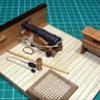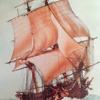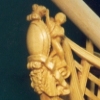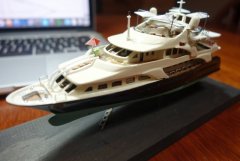Supplies of the Ship Modeler's Handbook are running out. Get your copy NOW before they are gone! Click on photo to order.
×
-
Posts
5,871 -
Joined
-
Last visited
Reputation Activity
-
 BANYAN got a reaction from Rudolf in HMCSS Victoria 1855 by BANYAN - 1:72
BANYAN got a reaction from Rudolf in HMCSS Victoria 1855 by BANYAN - 1:72
Hi folks, I have made some progress on the winches, with the parts now all turned, photoetched etc. I have managed to put the ironwork (brass) for one of them together but still to add the wooden 'bed'. The photos show the progress as I went along but still a lot of cleaning up to do. Most of this is fine metal powder, but a few 'dags' here and there to fix.
The whole assembly is only 15mm long by 11mm high. The small handwheel was purchased but the rest of the parts including the larger hand wheel, except the tapered drum which I turned, are PE that I drew up and had etched. The slightly grooved effect n the drum is deliberate as it had grooves for the first turns of the wire to lay up into. I have styled this after a winch illustrated in Underhill's 'Masting and Rigging the Clipper Ship and Ocean Carrier'.
The cog wheel is two pieces of .2mm bras with tiny alignment holes which allowed me to solder them together and keep the teeth aligned. The worm gear is still beyond my skills so I simply used some brass tube (1.5 mm). The other handwheel is set into a short length of 1.0 mm tube, which is then partially inserted into some small brass square section, to represent the gear box for the drum brake, which is made from thin copper (bends more easily).
The small ding in the tapered wire drum is bigger than planned but is intend as a 'flat' to let me drill through as a starting point for the steel wire rope that will be attached. The halliards (steel wire) were bent to the winch and remained there permanently with the tension held by the drum brake. My next problem is to work out how to fit this strongly enough to allow me to create a 'little' tension on the scaled halliards without pulling the winch away from the deck.
cheers
Pat
-
 BANYAN got a reaction from hexnut in HMCSS Victoria 1855 by BANYAN - 1:72
BANYAN got a reaction from hexnut in HMCSS Victoria 1855 by BANYAN - 1:72
Hi folks, I have made some progress on the winches, with the parts now all turned, photoetched etc. I have managed to put the ironwork (brass) for one of them together but still to add the wooden 'bed'. The photos show the progress as I went along but still a lot of cleaning up to do. Most of this is fine metal powder, but a few 'dags' here and there to fix.
The whole assembly is only 15mm long by 11mm high. The small handwheel was purchased but the rest of the parts including the larger hand wheel, except the tapered drum which I turned, are PE that I drew up and had etched. The slightly grooved effect n the drum is deliberate as it had grooves for the first turns of the wire to lay up into. I have styled this after a winch illustrated in Underhill's 'Masting and Rigging the Clipper Ship and Ocean Carrier'.
The cog wheel is two pieces of .2mm bras with tiny alignment holes which allowed me to solder them together and keep the teeth aligned. The worm gear is still beyond my skills so I simply used some brass tube (1.5 mm). The other handwheel is set into a short length of 1.0 mm tube, which is then partially inserted into some small brass square section, to represent the gear box for the drum brake, which is made from thin copper (bends more easily).
The small ding in the tapered wire drum is bigger than planned but is intend as a 'flat' to let me drill through as a starting point for the steel wire rope that will be attached. The halliards (steel wire) were bent to the winch and remained there permanently with the tension held by the drum brake. My next problem is to work out how to fit this strongly enough to allow me to create a 'little' tension on the scaled halliards without pulling the winch away from the deck.
cheers
Pat
-
 BANYAN got a reaction from albert in HMCSS Victoria 1855 by BANYAN - 1:72
BANYAN got a reaction from albert in HMCSS Victoria 1855 by BANYAN - 1:72
Hi folks, I have made some progress on the winches, with the parts now all turned, photoetched etc. I have managed to put the ironwork (brass) for one of them together but still to add the wooden 'bed'. The photos show the progress as I went along but still a lot of cleaning up to do. Most of this is fine metal powder, but a few 'dags' here and there to fix.
The whole assembly is only 15mm long by 11mm high. The small handwheel was purchased but the rest of the parts including the larger hand wheel, except the tapered drum which I turned, are PE that I drew up and had etched. The slightly grooved effect n the drum is deliberate as it had grooves for the first turns of the wire to lay up into. I have styled this after a winch illustrated in Underhill's 'Masting and Rigging the Clipper Ship and Ocean Carrier'.
The cog wheel is two pieces of .2mm bras with tiny alignment holes which allowed me to solder them together and keep the teeth aligned. The worm gear is still beyond my skills so I simply used some brass tube (1.5 mm). The other handwheel is set into a short length of 1.0 mm tube, which is then partially inserted into some small brass square section, to represent the gear box for the drum brake, which is made from thin copper (bends more easily).
The small ding in the tapered wire drum is bigger than planned but is intend as a 'flat' to let me drill through as a starting point for the steel wire rope that will be attached. The halliards (steel wire) were bent to the winch and remained there permanently with the tension held by the drum brake. My next problem is to work out how to fit this strongly enough to allow me to create a 'little' tension on the scaled halliards without pulling the winch away from the deck.
cheers
Pat
-
 BANYAN got a reaction from EdT in HMCSS Victoria 1855 by BANYAN - 1:72
BANYAN got a reaction from EdT in HMCSS Victoria 1855 by BANYAN - 1:72
Hi folks, I have made some progress on the winches, with the parts now all turned, photoetched etc. I have managed to put the ironwork (brass) for one of them together but still to add the wooden 'bed'. The photos show the progress as I went along but still a lot of cleaning up to do. Most of this is fine metal powder, but a few 'dags' here and there to fix.
The whole assembly is only 15mm long by 11mm high. The small handwheel was purchased but the rest of the parts including the larger hand wheel, except the tapered drum which I turned, are PE that I drew up and had etched. The slightly grooved effect n the drum is deliberate as it had grooves for the first turns of the wire to lay up into. I have styled this after a winch illustrated in Underhill's 'Masting and Rigging the Clipper Ship and Ocean Carrier'.
The cog wheel is two pieces of .2mm bras with tiny alignment holes which allowed me to solder them together and keep the teeth aligned. The worm gear is still beyond my skills so I simply used some brass tube (1.5 mm). The other handwheel is set into a short length of 1.0 mm tube, which is then partially inserted into some small brass square section, to represent the gear box for the drum brake, which is made from thin copper (bends more easily).
The small ding in the tapered wire drum is bigger than planned but is intend as a 'flat' to let me drill through as a starting point for the steel wire rope that will be attached. The halliards (steel wire) were bent to the winch and remained there permanently with the tension held by the drum brake. My next problem is to work out how to fit this strongly enough to allow me to create a 'little' tension on the scaled halliards without pulling the winch away from the deck.
cheers
Pat
-
 BANYAN reacted to rwiederrich in Great Republic 1853 by rwiederrich - FINISHED - four masted extreme clipper
BANYAN reacted to rwiederrich in Great Republic 1853 by rwiederrich - FINISHED - four masted extreme clipper
I’m sure it’s smaller then scale, it’s strong though. The larger wire looked to bulky to me
-
 BANYAN reacted to rwiederrich in Great Republic 1853 by rwiederrich - FINISHED - four masted extreme clipper
BANYAN reacted to rwiederrich in Great Republic 1853 by rwiederrich - FINISHED - four masted extreme clipper
Belayed sail control lines to the pin rails...still need to add rope coils.
-
 BANYAN got a reaction from Omega1234 in HMCSS Victoria 1855 by BANYAN - 1:72
BANYAN got a reaction from Omega1234 in HMCSS Victoria 1855 by BANYAN - 1:72
cheers mate; appreciate your compliment.
cheers
Pat
-

-
 BANYAN reacted to G.L. in Fishing Smack c. 1920 by G.L. - FINISHED - Scale 1/20 - POF - cross-section
BANYAN reacted to G.L. in Fishing Smack c. 1920 by G.L. - FINISHED - Scale 1/20 - POF - cross-section
Part 17:The outside planking
Time to plank the model at the outside.
I make the division between the garboard strake and the stringers. There will be seven planks, so I measure the distance on the forward frame between the two with a strip of paper.
I use a fan planking template to determine the seven plank widths on this frame...
... and mark the division on the frame.
I do the same on the after frame and start to plank. I work from the sides to the middle and mark the position of the frames on each plank. That will help me later to determine the positions for the tree nails.
First part completed.
The whole starboard side planked
I will leave open two holes in the planking of the port side to give sight on the frames.
Outside planking completed.
Before I can start to tree nail, I have to spend an afternoon splitting bamboo and pull the sticks through the draw plate to supplement my stock of tree nails.
Drilling the nail holes
and inserting the bamboo nails
The nailed hull
After sanding
-
 BANYAN reacted to Omega1234 in Genesis by Omega1234 - FINISHED - 1/300 - 49 m Mega Yacht
BANYAN reacted to Omega1234 in Genesis by Omega1234 - FINISHED - 1/300 - 49 m Mega Yacht
Hi folks.
Just a quick update on the progress of Genesis’ RIB tender. Almost finished, apart from some finessing and sanding.
I hope you enjoy the following photos.
Thanks
Patrick
-
 BANYAN got a reaction from mtaylor in Genesis by Omega1234 - FINISHED - 1/300 - 49 m Mega Yacht
BANYAN got a reaction from mtaylor in Genesis by Omega1234 - FINISHED - 1/300 - 49 m Mega Yacht
Nice work Patrick, that is looking very good!
cheers
Pat
-
 BANYAN got a reaction from mtaylor in Straightening thin brass wire
BANYAN got a reaction from mtaylor in Straightening thin brass wire
Vossy, Hobby Tools Australia in Melbourne stocks K&S wire and posts out very quickly
cheers
Pat
-
 BANYAN got a reaction from popeye the sailor in Falls of Clyde 1878 by GAW - FINISHED - scale 1:96 - iron 40-frame hull center cross-section
BANYAN got a reaction from popeye the sailor in Falls of Clyde 1878 by GAW - FINISHED - scale 1:96 - iron 40-frame hull center cross-section
Hi Gerald, a happy New Year to you and your family.
Thanks for the pointer to your website. As has been commented but much more experienced modellers, I also find your work inspirational. Whenever I run into a metalsmithing 'roadblock' I always return to your work and see what is achievable - that usually gets me motivated, not that I am anywhere near your skill level.
cheers
Pat
-
 BANYAN got a reaction from popeye the sailor in Great Republic 1853 by rwiederrich - FINISHED - four masted extreme clipper
BANYAN got a reaction from popeye the sailor in Great Republic 1853 by rwiederrich - FINISHED - four masted extreme clipper
That looks very good Rob, the level of detail at the scale you are building is excellent.
cheers
Pat
-
 BANYAN got a reaction from popeye the sailor in Great Republic 1853 by rwiederrich - FINISHED - four masted extreme clipper
BANYAN got a reaction from popeye the sailor in Great Republic 1853 by rwiederrich - FINISHED - four masted extreme clipper
You would never of known had you not tried Rob. One day a new idea may 'pop-into your head' but for now we will enjoy the sails you have done.
cheers
Pat
-
 BANYAN got a reaction from popeye the sailor in Great Republic 1853 by rwiederrich - FINISHED - four masted extreme clipper
BANYAN got a reaction from popeye the sailor in Great Republic 1853 by rwiederrich - FINISHED - four masted extreme clipper
On the other hand, if you can pull it off, I think it would look OK and something 'different'. That said, would not the course be one of the first major sails set?
cheers
Pat
-
 BANYAN got a reaction from popeye the sailor in HMCSS Victoria 1855 by BANYAN - 1:72
BANYAN got a reaction from popeye the sailor in HMCSS Victoria 1855 by BANYAN - 1:72
cheers mate; appreciate your compliment.
cheers
Pat
-
 BANYAN got a reaction from popeye the sailor in HMCSS Victoria 1855 by BANYAN - 1:72
BANYAN got a reaction from popeye the sailor in HMCSS Victoria 1855 by BANYAN - 1:72
Thanks for looking in and the comments Carl, Mark and Patric - much appreciated. Now to attack the circular skylights, that is going to be a bit of a challenge but only 4 to make 😨 - .
cheers
Pat
-
 BANYAN got a reaction from Rudolf in HMCSS Victoria 1855 by BANYAN - 1:72
BANYAN got a reaction from Rudolf in HMCSS Victoria 1855 by BANYAN - 1:72
Another small update folks. This shows some of the completed parts in-situ but the 'pelorus' is only dry fitted. I have yet to add the connection point (hydrant) for the 7" fire pump between the two suction plate assemblies, and a few sounding pipes. There is also a brass (single) rail to go around this area.
Dave, the laser cut came up well; many thanks to you and your mate for organising this for me. The rod grills are made from PE verticals and .6mm brass wire/rod which I soldered at the ends (each rod) and spot soldered two rods only for the inner ones. I have rebated a length of 0.5mm brass rod into the centreline piece of the skylight to represent a 'piano style' hinge with the edges screwed off against the sides of the panels in real life.
Unfortunately the laser cut ply came up a little darker than the rest of the wood (Kauri) but I think I can live with it I have also fitted the two 'L' handles for the downton pumps against the rear end of the skylight. These were only fitted when required. The dado along the bottom is 8" (actual) which corresponds with the dado on the circular skylights (4 of, still to be made) which will be fitted two abreast between the pelorus and companion, and the other two abreast aft of the companion.
cheers
Pat
-
 BANYAN got a reaction from popeye the sailor in HMCSS Victoria 1855 by BANYAN - 1:72
BANYAN got a reaction from popeye the sailor in HMCSS Victoria 1855 by BANYAN - 1:72
Thanks guys, a learning curve but well worth the effort
Not long for the completed assembly Dave; a tad distracted with babysitting duties today.
cherers
Pat
-
 BANYAN got a reaction from popeye the sailor in HMCSS Victoria 1855 by BANYAN - 1:72
BANYAN got a reaction from popeye the sailor in HMCSS Victoria 1855 by BANYAN - 1:72
Hi Dave and Carl; thanks for looking in and comments.
Dave, I drew the base artwork marking what I needed as etched on the underside or upper side, showing where I need holes etc. these were done to the required print/etch scale in TurboCAD and passed to the etcher who imported them and turned them direct into his 'negatives'. This is a screen grab of wwhat I drew up.
Many thanks again for organising the lasercut for me; it has worked out well with the PE fitting very well. Now to glue the assemblies together and add the 'dadoes'.
Carl, I finally caught up with a guy (Model Railroad community here in Melbourne) who had done some etching for my Endeavour and he did this job for me. I do so little that it is not worth the added expense/complication of learning yet another skill.
Still a bit more photoetch to be done for all the mast work etc, but that will come in due course Most of this is for the Rigmaiden Lanyards, purchase winches etc.
cheers
Pat
-
 BANYAN got a reaction from hexnut in HMCSS Victoria 1855 by BANYAN - 1:72
BANYAN got a reaction from hexnut in HMCSS Victoria 1855 by BANYAN - 1:72
Hi folks, another small update. Now that I have the PE in hand I can progress on a bit; still waiting for the 3D parts (capstan and revised funnel). I also had some laser parts cut for the engine room skylight as my attempts to make them kept breaking (stiles and rails) as the walls are only .6mm thick and the rails /stiles just .8mm. They have come up OK considering the size.
One of the reasons for lack of updates is that I had been busy drawing up all these part. The two sheets of PE are 0.4mm (larger sheet) and 0.2mm.
I am in the process of doing the glazing and have added the 'waffle' style ventilation louvres discussed earlier. The louvers were made from 0.2mm thick brass sheet and folded and soldered to get the effect seen in the photo earlier - they look OK I think? My biggest decision is whether to add another louvre in the front and after walls. I show a blank and a louvre version in the photos, but have an additional one of each.
My thoughts are to go for blank (no louvre) as I think there would have been adequate ventilation from the louvres and top pieces? The reasoning is that the after wall would most likely have been used to store the firehose racks, and supplementary 'L' shaped handle for the Downton pumps (only shipped as required.
I have started on the rod/bar grills for the top pieces with the parts shown before cleaning (one made, one unmade); the rods are only 0.6mm diameter. These have since been blackened but I forgot to take a photo. When the glazing in the top pieces have dried completely these will be glued over the windows / glazed parts.
I have also made the bases for the pumps, and manufactured one of the two suction plate assemblies required. The idea was that the connecting pipe(rounded/horseshoe shape) could be cross-connected to any one of three suction pipes (one to each major compartment/space). The top end of the pipe ran underdeck between the pipe and this plate assembly. I still have a 7" hose connection plate (single) to make which was the upper deck connection to the pump in the engine room (for firefighting) whereas the other two are for dewatering and transferring freshwater around the ship. The wood looks rough but I am zoomed right in and actually looks very smooth to the eye.
The 'pelorus' has also been completed. The 'hollow' look of the brass night cover for the compass is a trick of the light as I have painted that face silver to simulate the viewer.
These parts will be fitted once the engine room skylight has been fitted.
cheers
Pat
-
 BANYAN got a reaction from popeye the sailor in Bristol Pilot Cutter by michael mott - 1/8 scale - POF
BANYAN got a reaction from popeye the sailor in Bristol Pilot Cutter by michael mott - 1/8 scale - POF
If you can do that with a head cold, it is no wonder your other work is so good.
cheers
Pat
-
 BANYAN got a reaction from popeye the sailor in Bristol Pilot Cutter by michael mott - 1/8 scale - POF
BANYAN got a reaction from popeye the sailor in Bristol Pilot Cutter by michael mott - 1/8 scale - POF
Very nice work Michael, and a mioni-tutorial on making those slotted round head screws to boot She will be a work of art and just too nice to put into the water
cheers
Pat
-
 BANYAN got a reaction from popeye the sailor in Bristol Pilot Cutter by michael mott - 1/8 scale - POF
BANYAN got a reaction from popeye the sailor in Bristol Pilot Cutter by michael mott - 1/8 scale - POF
Great ideas and technique Michael, the support for the saw blade is one that I will definitely file away.
cheers
Pat








